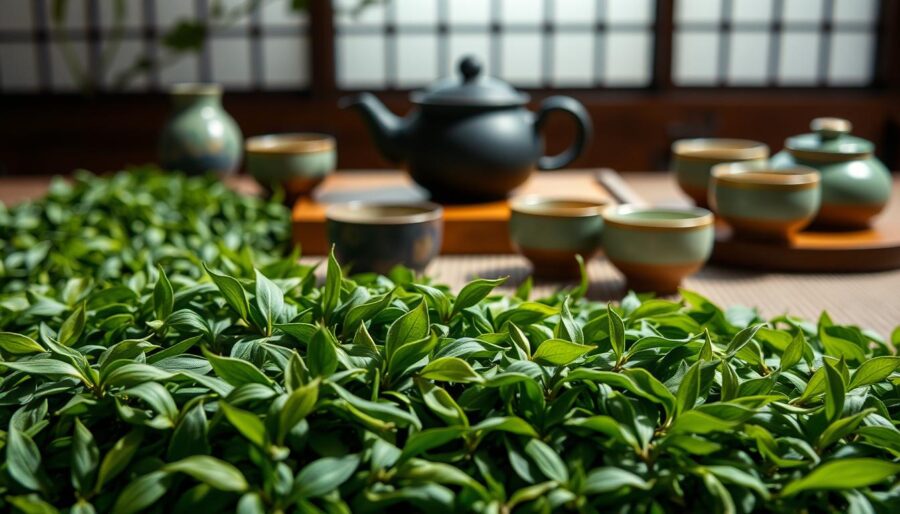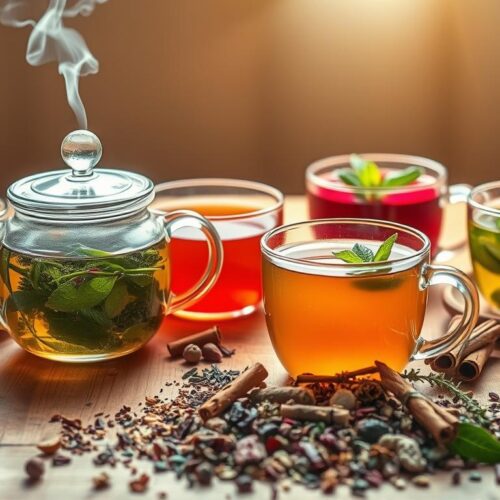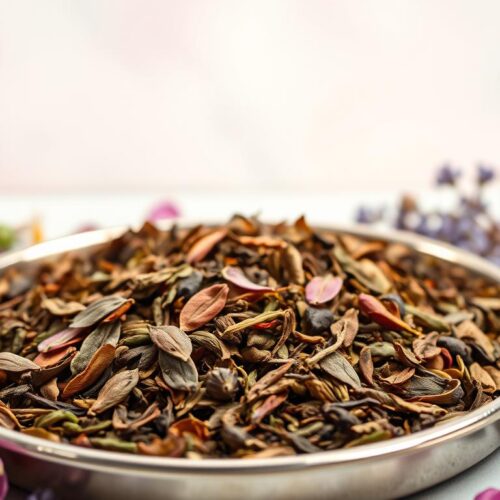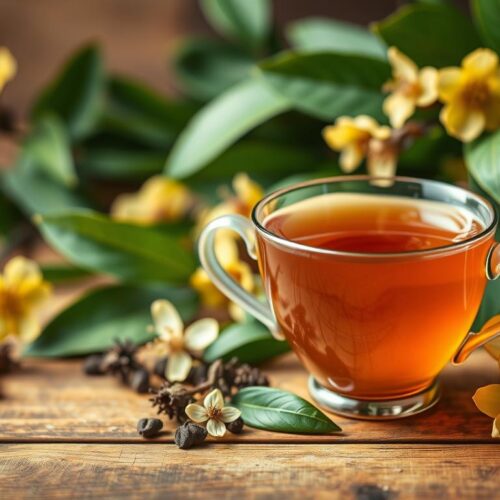Green tea is more than just your daily sencha. This guide gives you easy-to-follow info on different green teas. Learn what makes Japanese green tea special in terms of its creation, origin, and taste.
All true tea comes from the Camellia sinensis plant. The key difference in green teas is how they stop the leaves from oxidizing. In Japan, they steam the leaves quickly after picking. Then, they roll and dry them into narrow shapes. This keeps their color bright and taste fresh.
Japan is a leading tea producer, famous for its attention to detail. Shizuoka makes about 40% of Japan’s sencha. Uji, Kyoto, is known for its premium tea with a sweet taste. Kagoshima and Mie bring unique flavors with their special soils and climates. Each area makes the tea taste unique.
There are many popular types of green tea. Sencha is what people drink daily. Gyokuro is grown in the shade and has a strong umami flavor. Matcha is ground tea leaves you mix and drink. Hojicha has a roasted taste and less caffeine. Genmaicha mixes tea with toasted rice, and Bancha is a softer tea for everyday.
The flavor changes based on where and how the tea is grown and made. The color can range from light yellow-green to rich emerald. Matcha is thick and creamy. Green tea is good for your heart, brain, and can lower inflammation. This is due to polyphenols, EGCG, and L-theanine in the tea. The amount of caffeine differs, with gyokuro having more and hojicha less.
In the next sections, we’ll show you how to pick, make, and enjoy Japanese green tea. We’ll cover the best water temperatures and what foods go well with tea. This guide simplifies complex topics. It helps you appreciate the fine qualities of gyokuro and other teas.
What is Green Tea?
Green tea comes from the Camellia sinensis plant. Alongside black, oolong, pu-erh, and white teas, it’s unique. Its early oxidation stop gives it fresh flavors and a clean finish.
In Japan, makers steam the leaves for a bright color and grassy scent. Chinese green tea, however, gets a toasty flavor from pan-firing. Yet, Japan’s hojicha, though roasted, also begins with steaming. These processes lead to fine, needle-like Japanese tea shapes after cooling, rolling, and drying.
The taste of green tea can vary a lot. It depends on the tea’s type, where it’s grown, and how it’s steamed. Light-steamed asamushi is crisp, while deep-steamed fukamushi offers a richer taste. Different green teas can have a smooth sweetness, a light umami, or a sharp, tangy kick.
Green tea caffeine levels are usually between 30–80 mg per cup. This is less than what’s found in coffee. Specific types like gyokuro have more caffeine, while hojicha has less. L-theanine in green tea helps with calm focus, avoiding the jitters from coffee.
Drinking green tea regularly can boost blood flow and lower bad cholesterol. It can also support heart health with an active lifestyle and healthy eating. Green tea’s polyphenols, catechins like EGCG, and L-theanine improve well-being. These beneficial substances are found across green tea varieties.
| Aspect | Japanese Green Tea | Common Chinese Styles | What It Means for You |
|---|---|---|---|
| Processing | Steamed, then rolled and dried | Pan-fired, then shaped and dried | Steaming keeps grassy notes; firing adds toast |
| Leaf Shape | Needle-like strands (sencha, gyokuro) | Flat, curled, or spear-shaped | Shape hints at mouthfeel and brew speed |
| Flavor Range | Umami-forward, marine, sweet | Nutty, chestnut, floral | Lets you pick from green tea types that fit your palate |
| Caffeine | Higher in gyokuro; lower in hojicha | Moderate, varies by leaf and grade | Choose energy level without switching to coffee |
| Steaming Depth | Asamushi (light), fukamushi (deep) | N/A; heat is through pan-firing | Controls clarity vs. body in the cup |
| Wellness Compounds | Rich in EGCG and L-theanine | High in polyphenols and catechins | Supports heart health and focused calm |
Discovering green tea shows how origin and making affect its taste and effect. Japanese teas burst with color and umami. Pan-fired types tend to be warm and nutty. The wide variety of green teas means you can find the perfect match for your mood and daily routine.
Popular Green Tea Types
Many types of green tea are enjoyed, but three are especially popular in Japanese cups. Each presents a unique journey from leaf to flavor. Your choice can change the drink’s aroma, color, and feel.
Sencha is common in Japan, found everywhere from homes to vending machines. Its leaves are steamed, rolled, and dried which captures a fresh, grassy flavor. Use one teaspoon per cup and brew at 158–176°F for 45–60 seconds, for a light yellow-green color and fresh taste. Try fukamushi sencha for a deeper flavor; it’s steamed longer for a richer color and milder taste.
Matcha is made from shade-grown tencha, which is de-stemmed and ground. You mix it into hot water, consuming the entire leaf. This gives you more L-theanine and caffeine. Heat water to about 176°F and whisk until it’s foamy. Ceremonial grade is great for drinking, while culinary grade is best for cooking. Its flavor is sweet-umami with a creamy texture.
Gyokuro, a top shade-grown tea, is covered for 20 days to increase chlorophyll and amino acids. Brew it cool, at 122–140°F, for 2–3 minutes with one teaspoon per cup. The tea is pale to jade green, rich, and sweet, with a lasting umami flavor. Gyokuro is often saved for special, calm moments due to its limited yields.
- If you want bright and daily-friendly Japanese green tea, pick sencha.
- If you want a creamy, whisked cup with intensity, choose matcha.
- If you want a soft, sweet infusion with depth, explore gyokuro.
Understanding these main types helps you explore the wide variety of green tea. You can then find the perfect tea to fit your mood, time, and menu.
Exploring Japanese Green Teas
Trying hojicha, bancha, and genmaicha lets you see the variety of Japanese green tea. Although they all start as steamed green tea, each type has its own unique roast, aroma, and body. This makes each one perfect for different times of your day.
Hojicha is roasted until its leaves turn from green to reddish-brown. This gives it toasty and nutty flavors with a smooth earthy finish and sweet caramel hints. It has low caffeine, so you can enjoy it in the evening without it keeping you awake.
Bancha is picked later in the season, making it an everyday tea. It tastes mild and simple, and it’s more affordable than the highest quality sencha. It’s a strong tea that pairs well with food and is easy on your taste buds.
Genmaicha is a mix of green tea and roasted brown rice, sometimes including popped kernels. It smells warm and inviting. The flavor nicely balances savory with green tea’s freshness, making it less bitter. Some even mix in matcha to deepen the green color and enrich the taste.
For the best taste quickly, just use hot water and steep for a short time. Use almost boiling water for hojicha for about a minute. Bancha and genmaicha do well at around 180°F for 1 to 1.5 minutes. You can adjust the amount of tea and brewing time to make it sweeter or stronger as you like.
| Tea | Origin & Base | Processing | Flavor & Aroma | Color in Cup | Caffeine | Brewing Guide | Best For |
|---|---|---|---|---|---|---|---|
| Hojicha | Japanese green tea from steamed leaves, stems, or twigs | High-heat slow roasting after drying | Toasty, nutty, earthy with caramel-like undertones | Golden to dark brown | Low | Near-boiling water (~203°F), ~1–1.5 min; 1 Tbsp per cup; powder can be whisked | Evening sipping and smooth, cozy mugs |
| Bancha | Later-harvest Japanese green tea; everyday grade | Steamed, dried; larger, coarser leaves | Mild, straightforward, less astringent than many sencha | Light yellow to pale green | Moderate | Hot water ~175–185°F, ~1–1.5 min; 1 tsp per cup | Daily drinking, pairing with meals |
| Genmaicha | Blend of sencha or bancha with roasted brown rice | Steamed leaf plus toasted grains; sometimes matcha-iri | Fragrant, toasty, savory-nutty with soft vegetal notes | Light yellowish-green | Low to moderate | ~180°F, ~1–1.5 min; 1 tsp per cup | Comforting, food-friendly, gentle introduction to green tea types |
Learning about these tea classics, you understand how roasting, leaf quality, and blending change their flavors. With hojicha, bancha, and genmaicha, you’re ready for any mood or meal.
Discovering Chinese Green Teas
Exploring Chinese green tea is an adventure into a different craft. Unlike many Japanese teas, which are steamed, the Chinese prefer pan-firing their leaves. This technique sets the vibrant green color, softens the grassy taste, and brings out a toasty depth across various green teas. It creates a taste that’s warm, not just fresh.
Longjing tea, from Hangzhou, is famous for its flat, jade-colored leaves. Pan-firing gives it a smooth, nutty, and sweet flavor with only a little dryness. It has hints of soft chestnut and light toast, ending with a clean taste that makes you want to sip slowly.
Huangshan Maofeng tea, picked near the Yellow Mountain, has a floral and brisk character. Its tender buds give off a scent of mountain air and white blossoms, providing a gentle uplift. This tea showcases the bright side of Chinese green teas without the harshness.
Biluochun tea, also known as Green Snail Spring, is known for its tight, downy spirals. It starts with a fruity-floral aroma, then becomes delicate and silky on your palate. There’s a hint of perfume in every sip and a clean taste on your tongue.
Pan-firing clearly influences the character of these traditional teas. This method brings out chestnut, toasty, or floral notes, moving away from grassy flavors. Tasting and comparing these teas can help you understand their unique processing styles.
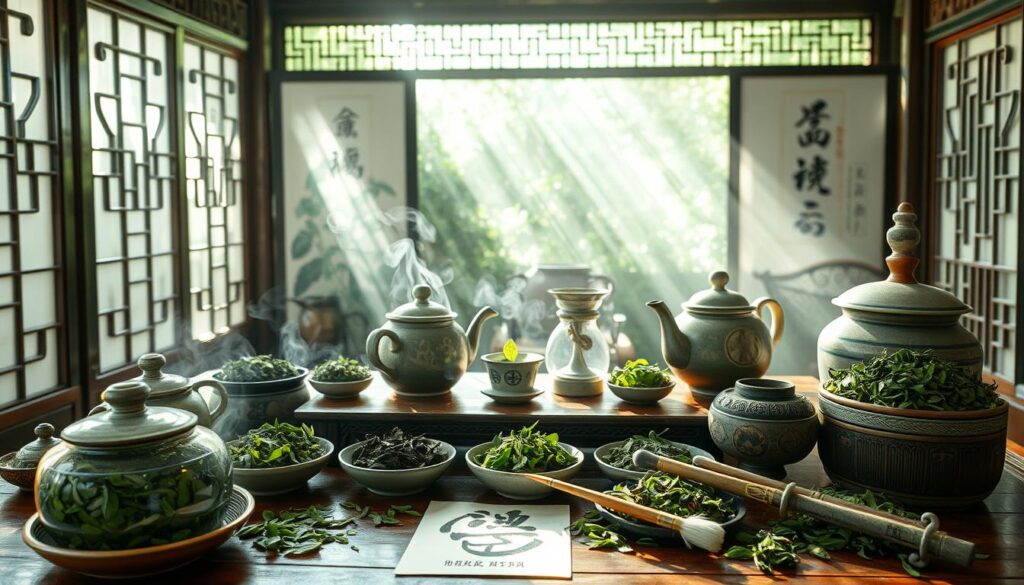
- Longjing: flat leaves, nutty-sweet body, low bite
- Huangshan Maofeng: tender buds, floral lift, brisk finish
- Biluochun: curled leaves, fruity-floral scent, delicate sip
When you try more Chinese green teas, pay attention to the shape of the leaves, the level of pan heat, and when they were picked. These details help you find the flavor that you like best. They make comparing different green teas easy and accurate.
Regional Differences in Green Teas
Every sip offers a taste of place. The soil, altitude, and craft define the color, aroma, and texture of green tea. In Japan, names like Uji-cha and Shizuoka-cha tell you where the tea comes from and how it was made. These hints assist in picking a tea that matches your taste, whether you prefer a bright or deep flavor.
Shizuoka is famous for producing a lot of sencha tea. It’s especially known for fukamushi, or deep-steamed tea. This process makes the tea smoother, deeper in color, and richer. On the other hand, Uji in Kyoto uses shading to grow gyokuro and tencha. This method makes the tea sweet and savory.
Kagoshima’s volcanic soil and warm air enrich the tea leaves. This makes the tea sweeter and gives it a rich green color. Even the position of the fields affects the tea, changing its astringency. As you try sencha from different areas, you’ll notice how it changes.
The season also plays a big role. The first flush, Ichibancha, and the new season’s tea, shincha, are fresh and clean. Later harvests, like bancha, are steadier and more everyday. In Japan, these harvest times highlight the unique qualities of each tea type.
| Region | Signature Styles | Key Practices | Typical Flavor Notes |
|---|---|---|---|
| Shizuoka | Sencha, Fukamushi Sencha | Deep steaming, river-valley gardens | Low astringency, thick body, vivid green |
| Uji (Kyoto) | Gyokuro, Tencha, Premium Sencha | Intensive shading, meticulous hand-finishing | High umami, sweet finish, silky texture |
| Kagoshima | Sencha, Kabusecha | Volcanic soils, warm climate, mixed shading | Rounded sweetness, bright color, gentle bite |
| Mie (Ise) | Sencha, Ise-cha | Coastal influence, balanced steaming | Crisp aroma, clean snap, balanced umami |
| Saitama (Sayama) | Sayamacha | Cool nights, thicker leaves | Rich body, toasty edge, moderate astringency |
| Shizuoka (Kawane) | High-elevation Sencha | Mountain gardens, misty mornings | Fragrant, brisk, refined sweetness |
Let the origin on the label be your guide. For rich color and smoothness, try Shizuoka’s fukamushi sencha. Uji is the go-to for velvety umami flavors. And for a sweet, sunny experience, Kagoshima is ideal. This is how you navigate the diverse world of Japanese green tea.
The Art of Brewing Green Tea
To make the best green tea, match your water and temperature with the tea type. Use soft, filtered water. Make sure you don’t boil it too much, unless the tea type needs it. A special teapot called a kyusu is perfect for Japanese green tea. It lets the leaves open up, which makes the tea smell and taste better.
Getting the right temperature is key for the perfect balance of sweet and sharp flavors. Sencha tea is best at 158–176°F. Genmaicha prefers a temperature around 180°F. Hojicha can handle hotter water, near boiling. Gyokuro is best cooler, at about 122–140°F. For matcha, keep it near 176°F and whisk it until it’s smooth.
When brewing green tea, don’t steep it for too long to avoid a bitter taste. Most Japanese green teas are good after 45–90 seconds. Sencha is best after 45–60 seconds. Genmaicha and hojicha need 60–90 seconds. Gyokuro should steep for 2–3 minutes. For matcha, just whisk until it’s fully dissolved.
Be careful with how much tea you use. About 1 teaspoon per cup is right for most kinds. Hojicha is lighter, so use about 1 tablespoon. For matcha, a teaspoon (or about 3 grams) is enough. If you have a bamboo chasen, it’s the best tool to whisk it.
Don’t forget you can use the leaves more than once. Japanese green tea can often be steeped up to three times. Each time, the taste changes from rich and smooth to sharp and refreshing. Make the second infusion shorter to keep it sweet, and slightly increase the heat on the third to bring out a toasty flavor.
Cold brewing is a soft and clean method. For a smooth taste with low bitterness, cold brew sencha or genmaicha in the fridge for a few hours. Then, pour it over ice. This way highlights the tea’s floral and grainy notes while keeping it less bitter.
- Water: Soft, filtered; cooler for delicate styles.
- Heat: Sencha 158–176°F; genmaicha ~180°F; hojicha hot; gyokuro 122–140°F; matcha ~176°F.
- Time: Sencha 45–60s; genmaicha/hojicha 60–90s; gyokuro 2–3 min; matcha whisk only.
- Ratios: Leaf teas ~1 tsp per cup; hojicha ~1 tbsp; matcha ~1 tsp (≈3 g).
- Re-steeps: Up to three infusions, adjusting time and heat.
- Cold brew: Ideal for deep-steamed sencha and genmaicha.
Flavor Profiles of Green Teas
Exploring different types of green tea, you’ll find a wide range of tastes. Steamed Japanese teas like sencha and gyokuro have a grassy, sea-like, and deeply savory flavor. Deep-steamed sencha displays a more robust taste, less sharpness, and a bright green color.
Roasted green teas offer a different experience. Hojicha has a toasty, nutty, and somewhat sweet flavor. Genmaicha, which mixes tea with roasted rice, gives you a popcorn-like scent. This combination softens the sharpness for a smoother finish.
Chinese green teas that are pan-fired lean towards chestnut and floral notes. Longjing has a slight nuttiness and a smooth texture. Biluochun is lightly aromatic, featuring sweet flowers and a crisp finish.
The balance between sweetness and bitterness changes with the growth of the leaves and brewing methods. Shade-grown teas like gyokuro, tencha, and matcha have more sweetness and savory taste. This is because they have more L-theanine and chlorophyll. Unshaded green teas might be sharper, but using cooler water and shorter brewing times can soften this.
Matcha provides a strong savory taste with a hint of bitterness as you drink the whole leaf. Gyokuro brewed with care is thick and has a sweet-savory flavor. Genmaicha becomes milder with its roasted rice. Meanwhile, hojicha’s roasting process reduces its bitterness and caffeine, making it smooth and comforting.
Matching the tea’s origin with its brewing method can enhance its flavor. If you like a taste reminiscent of the ocean, try sencha or gyokuro. If you prefer a nutty smoothness, hojicha is a good choice. For teas with a chestnut and floral touch, check out Longjing or Biluochun. This variety is what makes tasting green teas so rewarding.
- Grassy and umami: steamed Japanese varieties like sencha and gyokuro
- Toasty and nutty: roasted hojicha and the rice-kissed comfort of genmaicha
- Chestnut and floral: pan-fired Chinese classics such as Longjing and Biluochun
- Sweet-bitter balance: shade-grown matcha and gyokuro versus brighter unshaded types of green tea
Green Tea and Culinary Uses
Japanese green tea can make your cooking vibrant in color, smell, and taste. Matcha, mixed into lattes, smoothies, and ice creams, turns them green and creamy. Full leaf consumption boosts caffeine and L-theanine, aiding calm and focus.
Culinary grade matcha suits batters and doughs; ceremonial grade is best with hot water. You can add matcha to chiffon cakes or tiramisu for a special flavor. These choices are great for health-focused kitchens.
Hojicha adds roasted, caramel, and cocoa hints. Mix hojicha powder into panna cotta, cookies, or warm lattes. It goes well with dairy or oat milk, sweetening desserts just right.
Genmaicha mixes tea and roasted rice, giving a toasty taste to stocks or broths. Use its brew to cook rice for a unique flavor. Matcha-iri genmaicha enhances sweets or onigiri with its color and depth.
Think like a chef when using green tea. Begin with little, taste often, and balance the flavors. This way, matcha and hojicha will complement chocolate, citrus, or dairy perfectly.
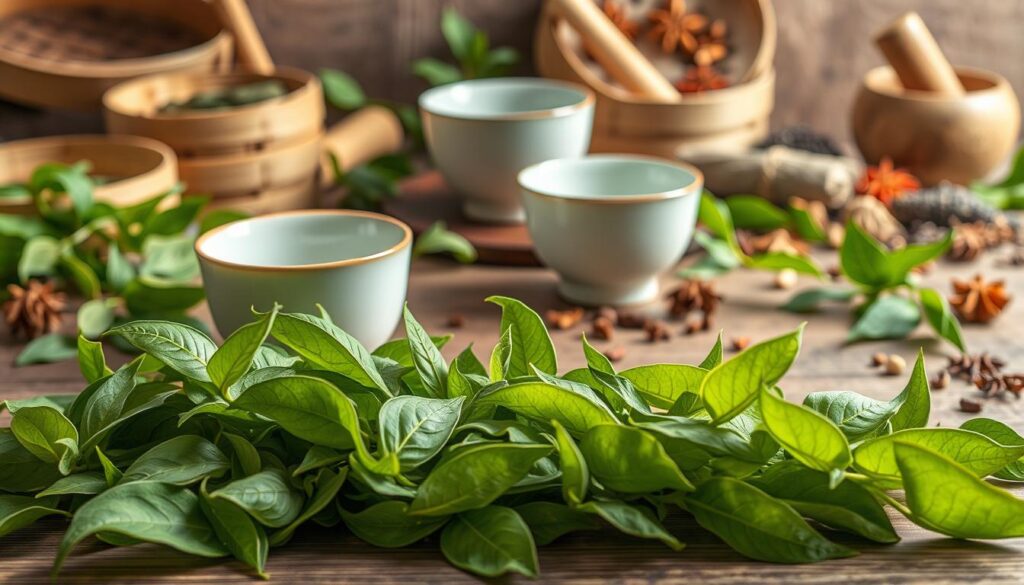
| Ingredient | Flavor Profile | Best Uses | Tips | Example Pairings |
|---|---|---|---|---|
| Matcha (Japanese green tea) | Grassy, sweet umami | Lattes, smoothies, custards, cookies | Use culinary grade for baking; sift to prevent clumps | White chocolate, lemon zest, mascarpone |
| Hojicha | Roasted, caramel-like, low bitterness | Lattes, panna cotta, shortbread | Whisk powder into warm milk; avoid over-sweetening | Brown sugar, milk, almond butter |
| Genmaicha | Toasty, nutty, light body | Broths, rice cooking liquid, savory sauces | Steep gently to keep clarity; use as a base for grains | Miso, shiitake, sesame oil |
| Matcha-iri Genmaicha | Toasty with green depth | Confections, glaze for cakes, flavored rice | Blend for even color; balance salt and sweetness | Honey, toasted coconut, sea salt |
- Quick drink: Shake matcha with cold water, ice, and a touch of honey.
- Hojicha latte: Warm milk, whisk in hojicha powder, finish with cinnamon.
- Savory twist: Poach chicken in genmaicha for a clean, nutty note.
- Dessert idea: Fold matcha into whipped cream for fruit parfaits.
By blending types of green tea into your meals, you add new textures and flavors. Matcha and hojicha make desserts balanced and delicious. Genmaicha brings a warm touch to simple, comforting dishes.
Green Tea Variations
Green tea comes in many types, each with its own flavor, color, and strength. Some types add different plants for taste, others use various parts of the tea leaf or different steam times. This variety means you can find one that perfectly suits your taste and how much caffeine you want.
Flavored green teas are great for beginners. They mix things like citrus peel, jasmine, mint, or bergamot into teas like sencha. This creates a tea with a wonderful smell and a smoother taste. It’s a good way to start enjoying green tea without the strong flavors of pure-leaf teas.
Japan is known for its blended green teas. Genmaicha is a mix of green tea and toasted brown rice, giving it a warm, nutty taste. Kukicha combines stems, stalks, and twigs, offering a mild, nutty flavor with less caffeine.
Changing the process also leads to unique types of green tea. Fukamushi sencha is deeply steamed to make it fuller and less sharp. Teas like kabusecha are shaded before picking, enhancing their smoothness and umami flavor. Tencha, used for matcha, offers a delicate taste when brewed on its own.
Trying different teas side by side lets you see the impact of the leaf part, shade, and steam time. The guide below can help you find the tea that’s just right for your daily needs.
| Variation | What It Is | Flavor Profile | Caffeine | Why Choose It |
|---|---|---|---|---|
| Flavored green tea | Sencha or similar base with fruits, flowers, herbs, or essences | Aromatic, approachable, notes of citrus, jasmine, or mint | Moderate (depends on base) | Easy gateway to pure-leaf teas; versatile hot or iced |
| Blended green tea (Genmaicha) | Sencha or bancha blended with roasted brown rice | Toasty, cereal-like, smooth sweetness | Lower to moderate | Comforting daily drink; forgiving to brew |
| Blended green tea (Kukicha/Bōcha) | Blend of stems, stalks, twigs, and leaf pieces | Mild, nutty, clean finish | Lower than leaf-heavy teas | Gentle on evenings; rich in minerals |
| Fukamushi Sencha | Deep-steamed sencha with broken leaf particles | Full-bodied, vivid green liquor, reduced astringency | Moderate | Dense mouthfeel and bold color in short steeps |
| Kabusecha | Shaded 7–10 days, between sencha and gyokuro | Round, umami-rich, soft sweetness | Moderate | Balanced price-to-flavor; elevated L-theanine |
| Tencha | Flat-dried, de-stemmed shaded leaf used for matcha | Delicate, silky, very low astringency | Moderate | Refined sipping; insight into matcha’s raw material |
To discover different green teas, start with a flavored one and a classic sencha. Then, try a blend like genmaicha or kukicha. Include a fukamushi or kabusecha to see how different processes change the tea. End with tencha for a smooth finish.
The Growing Trend of Green Tea
Green tea is found everywhere nowadays. It’s served at sushi bars in the U.S., and you can find it in grocery stores. You’ll see Matcha in cafes, bakeries, and in cans ready to drink. Hojicha lattes bring a toasty flavor, and genmaicha offers warmth on hectic days.
You’re becoming curious about where it comes from and how it’s made. Maybe you’ll try green tea from Uji, Japan, or give fukamushi sencha a shot for its rich taste. If you’re after a smooth taste with a mellow boost, shade-grown gyokuro is your go-to. These choices let you explore different textures, smells, and traditions of green tea.
Health benefits attract your attention. You search for substances like EGCG, antioxidants, and anti-inflammatory components. The mix of L-theanine and caffeine in tea keeps your focus sharp without making you jittery. This makes matcha a go-to in the morning or before studying. You prefer green teas that are simple and from clear sources, to drink every day.
Brands are embracing the importance of being mindful. Starbucks, Ito En, and Stash demonstrate how making your tea can alter its taste and your mood. Whisking matcha is perfect for a quick pause, while brewing sencha complements a meal nicely. Choosing teas grown in the shade increases theanine and chlorophyll. This aligns with your wellness goals by cutting down on sugar while increasing benefits.
| Style | Origins/Notes | Flavor & Feel | Popular Uses in the U.S. | Wellness Tie-In |
|---|---|---|---|---|
| Sencha (including fukamushi) | Japanese green tea; Uji and Shizuoka are sought-after | Grassy, bright; deep-steamed is fuller-bodied | Hot brews in restaurants; bottled iced tea | Daily antioxidants and hydration |
| Matcha | Stone-ground; ceremonial and culinary grades | Umami-rich, creamy when whisked | Lattes, pastries, smoothies, RTD cans | EGCG plus L-theanine for calm focus |
| Gyokuro | Shade-grown, premium harvests | Savory, sweet, high umami | Slow sips; special-occasion brewing | Elevated theanine and chlorophyll |
| Hojicha | Roasted leaves and stems | Toasty, low bitterness, lower caffeine | Lattes, soft serve, evening cups | Gentle option for late-day calm |
| Genmaicha | Sencha with roasted rice | Nutty, warm, comforting | Cafés and home brews with meals | Satisfying flavor without added sugar |
As you discover different kinds of green tea, you match their flavors to parts of your day. Matcha might be your choice in the morning for sharp focus. In the evenings, you might prefer the roasted taste of hojicha. Weekends are perfect for experimenting with different brewing times and temperatures to find what suits your mood.
Buying and Storing Green Tea
The best Japanese green tea comes from knowing where and when it’s from. Look for labels from places like Uji or Kagoshima. Also, check for terms like ichibancha or shincha, and names like fukamushi or kabusecha to find your perfect flavor.
Sencha should be bright and smell like the sea. Gyokuro and tencha need to be deep green, showing they’re full of chlorophyll. For matcha, choose a bright green powder that’s smooth. Use ceremonial grade for drinking and culinary grade for baking.
When picking blends or roasts, use your senses. Genmaicha should have nicely roasted rice without a burnt smell. Hojicha needs to look and smell toasty. Always go for whole leaves and buy from trusted shops like Ippodo or Ito En.
Keep your tea fresh by protecting it from light, air, and moisture. Use airtight tins for storage. If your kitchen is warm, store unopened matcha and gyokuro in the fridge. Always let them warm up before you open them.
Use a small tin for what you use daily and keep the rest in a bigger, sealed bag. Enjoy shincha and matcha soon after buying for the best flavor. Most Japanese green teas taste best in the first few months, so only buy what you’ll use.
| Tea Type | What to Look For | Best Use | Storage Tip | Region Signals |
|---|---|---|---|---|
| Sencha | Vibrant green needles, fresh marine aroma, even leaf size | Daily drinking; fukamushi for fuller body | Airtight, opaque tin; cool, dry shelf | Shizuoka brightness; Kagoshima sweetness |
| Gyokuro | Deep emerald hue, rich umami, fine intact leaves | Low-temp, slow brews for umami | Refrigerate unopened; warm to room temp before opening | Uji depth; Yame silkiness |
| Tencha | Flat, dark green flakes, clean aroma, no stems | Stone-milled into matcha; delicate cold infusions | Seal tightly; short shelf life once opened | Uji shading traditions |
| Matcha | Opaque, vivid green powder; silky, clump-free texture | Ceremonial for sipping; culinary for lattes and baking | Refrigerate or freeze unopened; use within weeks after opening | Uji finesse; Nishio color intensity |
| Genmaicha | Evenly roasted rice, minimal burn, balanced leaf-to-rice mix | Comforting daily cups; food pairing | Dry, airtight storage away from odors | Shizuoka blends |
| Hojicha | Uniform roast, warm toasty scent, low astringency | Evening tea; low caffeine | Opaque tin; finish within months | Kagawa and Kyoto roasts |
| Kabusecha | Shaded leaves, sweet aroma, dark sheen | Bridging sencha and gyokuro profiles | Cool storage; limit air exposure | Mie shading methods |
Conclusion: Enjoying Green Tea’s Diversity
There’s a whole world of flavors ready for you. Pick a tea for the moment: sencha for balance, gyokuro for rich umami at low temps, and matcha for energy and creativity in cooking. Have hojicha in the evening for its calming effect with less caffeine, genmaicha for a toasty feel, and bancha for simple daily enjoyment. These types of green tea show how origin and making methods change taste and mood.
To enjoy green tea fully, adjust how you make it. Use cooler water and steep for less time to make it sweet, not bitter. You can use good quality leaves more than once, finding new flavors with each brew. Discover different making methods like kabusecha and tencha, the deep steam of fukamushi, and stem-rich kukicha to see the impact on color, smell, and caffeine amount.
Comparing teas from different places helps you understand them better. Taste tea from Shizuoka and then Uji to see how the environment affects the flavor. Try shincha in the spring, and later harvests, to find seasonal differences. Compare Japanese steamed teas to Chinese pan-fired ones like Longjing and Biluochun to explore different textures and tastes. Pay attention to the tea’s color, how it feels in your mouth, and the taste it leaves behind.
By choosing carefully, storing right, and brewing with attention, you discover the wide range of green teas. This helps you find your favorite ones in Japan’s rich tea culture. Keep trying new teas, enjoy each cup, and let your experiences lead you to new favorites.

